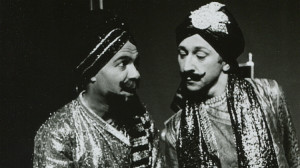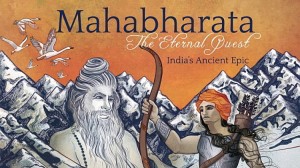A New Vrindaban Storyteller Releases New ‘Fast-Paced’ Mahabharata
A New Vrindaban Storyteller Releases New ‘Fast-Paced’ Mahabharata
By: Madhava Smullen for ISKCON News on Aug. 9, 2013.
Professional storyteller Sankirtana Das (Andy Fraenkel) has just published his own retelling of the great Vedic epic Mahabharata that stands out from the crowd with its unique fast-paced approach.
The book, Mahabharata: The Eternal Quest, is the culmination of years of experience in the dramatic arts, as well as a long relationship with the Mahabharata.
Young Andy Fraenkel first encountered the epic while living on New York’s Lower East Side and studying theater in college in the 1960s.
In his college library, he came across The Indian Story Book by Richard Wilson, which included several stories from the Mahabharata.
“The story of Yudhistira and the dog really jumped out at me,” he says.
Andy created a script based on the story, and turned it into a short play that became part of a full-length presentation his college theater group put on for elementary schools in the New York City area, along with The Emperor’s New Clothes and Rudyard Kipling’s The Elephant’s Child.
After this, Andy began to get more interested in Indian spirituality. He got a copy of ISKCON Founder Srila Prabhupada’s Bhagavad-gita As It Is at the ISKCON temple on 61 2nd Ave—Bhagavad-gita of course being a central part of the Mahabharata.
Then, in 1971, after graduating from college, he and his wife visited Nova Scotia to stay with another couple pursuing the arts. During their stay, they read the Bhagavad-gita more, bought and strung their own beads for chanting, and began to implement a vegetarian diet and cut out intoxicants.
After meeting Srila Prabhupada in Detroit later that year, they eventually joined ISKCON in Chicago in 1973, and were initiated by Srila Prabhupada as Sankirtana Das and Ruci Dasi.
“We knew we were making a very serious commitment,” Sankirtana says. “And at that time, I was ready to leave all my attachments about theater behind.”
Sankirtana became a dedicated missionary, spending his time distributing Srila Prabhupada’s books at Chicago’s O’Hare airport.
But in 1976, after moving to New Vrindaban in the West Virginia Hills, he began to think more deeply about what would come next for him.
“I began to realize that to stay in the movement for the long haul, I needed to be connected to some particular service,” he says. “I thought about getting into one of the arts and crafts, doing stained glass or pottery. And as I was trying to rack my brains as to what to do, I thought, ‘Wait a minute, I have something that I’m connected with—theater!’”
Starting the Theater Project in New Vrindaban, Sankirtana performed a one-man theater program called An Evening with Krishnadas Kaviraj. After a stint with the Vaikuntha Players in New York performing the Ramayana, he was joined back in New Vrindaban by Lokamangala Das of the Players when the group disbanded. The two had a close working relationship for a decade, putting on Nandulal: The Story of Bilvamangala Thakur; The Advent of Lord Krishna, The Ramayana, Lord Chaitanya and the Kazi, and Jada Bharat: Three Lives.
Throughout the 1980s, they would put together one play every year, and perform it through the summer for New Vrindaban visitors. Then, in 1987, their efforts culminated in a two-man performance of the Mahabharata.
“The international theater director Peter Brook was bringing his nine-hour Mahabharata to New York City, so we decided to develop our own Mahabharata,” Sankirtana says. “At first we tried to get more people involved. But when we saw that no one was going to make such a big commitment, we resigned ourselves to putting together a two-man Mahabharata.”
Sankirtana and Lokamangala performed their under two-hour Mahabharata for a five-week run in the 100-seat American Theater of Actors Off-Broadway in New York City, with a musician providing live musical accompaniment and Bharat Natyam dancer Deva Deva Jagat Pate performing dance.
Meanwhile, Peter Brook’s nine-hour Mahabharata production, with its forty actor cast and half a dozen musicians, played simultaneously.
Despite being much more low key, Sankirtana and Lokamangala’s play, referred to as ‘the other Mahabharata,’ was also reviewed in the New York Times, which stated that the duo “dedicate the work to their eternal Spiritual Master, His Divine Grace A. C. Bhaktivedanta Swami Prabhupada.”

Lokamangala Das and Sankirtana Das (right) perform their two-man Mahabharata Off-Broadway in New York City.
For four years, the two toured the Mahabharata at colleges, Hindu temples, and Rathayatra festivals around North America.
But then in 1991, Lokamangala moved away from the New Vrindaban community. And in 1994 Sankirtana suffered a major heart attack, rendering him unable to shoulder the intense task of producing plays.
A performer, however, is always a performer, whatever the medium. And so, undaunted, Sankirtana transitioned to solo dramatic storytelling.
“For the last twenty years, I’ve been a professional multicultural storyteller, telling stories from Indian, African, Jewish and Native American traditions,” he says. “I developed a repertoire of stories which I took to high schools, elementary schools, and colleges, and I also developed several workshops on the dynamics of storytelling.”
In 2005, Sankirtana Das received a West Virginia Artist Fellowship Award for his outstanding efforts in professional storytelling.
And in 2006, he was invited to the National Storytelling Conference in Pittsburgh, Pennsylvania, and told to submit three stories, of which he would tell one. He chose three stories from the Mahabharata.
“Devotees had been saying, ‘Why don’t you work on a film of the Mahabharata?’ But I didn’t have the capacity or energy for something like that,” he says. “So in 2000, I decided if I couldn’t make a movie I would write a treatment of the Mahabharata as if it were a film. It would be so visual, graphic and character and action driven, that when people read it it would be like watching a movie in their minds.”
When Sankirtana submitted his three stories the Storytelling Conference asked him to tell all three, which he did, in front of a thousand extremely appreciative listeners.
This encouraged him to refocus on the Mahabharata that year, in 2006. Finally, he once again refocused his energies on the epic in 2011, putting aside his other projects, and completed and published the work this year.
There have, of course, been many different versions of the Mahabharata, both outside of ISKCON and within, but Sankirtana’s brings its own unique style.
“Today’s culture is so visually driven, obsessed with Internet, video games, and movies,” he says. “So I wanted to make a Mahabharata available that addresses that inclination in our culture. I wanted it to be a fast-paced story, not bogged down with too much description and dialogue.”
In his relatively slim 280-page edition of the Mahabharata, Sankirtana attempts to retain the essence and depth of the story while always keeping it moving forward quickly. His years of experience in the dramatic arts, which he feels applies in all forms of art, helped him to keep this balance.
Sankirtana has geared his book towards a very broad audience, but hopes that the shorter, more digestible narrative will make it especially ideal for use in college classes compared to other editions, some of which near the 1,000 page mark.
At the same time, he has tried to make the book interesting to devotees who may already be familiar with the story by using narrative tricks and turns that keep readers on their toes.
“I have three prologues,” he says. “One with Bhumi and the demigods praying to Lord Vishnu in Svetadvipa; one about Vasishta Muni cursing the Vasus; and one of Lord Krishna telling a story about Dharma to Yudhistira.”
After these three prologues, the narrative jumps to Yudhistira walking across the battlefield at Kuruksetra to seek permission from Grandfather Bhisma and Dronacharya to engage in combat. Bhisma then thinks back on how it all came to this terrible war, and we flash back to the traditional beginning of the Mahabharata, wherein Bhisma’s father Shantanu meets his mother Ganga.
During the course of the narrative, Sankirtana ties all these different “loose ends” together, keeping even the most seasoned reader interested to see how he’ll do it. Through this, three important themes arise: Sankirtana helps the reader understand the nature of Dharma; the age of Kali; and Krishna’s relationship with his devotees the Pandavas.
Intriguingly, in relation to Krishna, Sankirtana recreates for his readers the experience that people had 5,000 years ago during the events of the Mahabharata. As ISKCON Founder Srila Prabhupada explains, a very small number of people actually knew that Lord Krishna was God Himself at the time.
Thus, not wanting to spoon feed his readers or bash them over the head, Sankirtana never mentions in his text that Krishna is God. Rather, he lets the other characters and events in the book steer them towards that natural conclusion: for instance, the way Grandfather Bhisma and others address Krishna as the Supreme, Krishna’s showing His universal form to Arjuna, and Krishna’s appearing instantly to save Draupadi when her modesty is attacked by Dusashana during the gambling match.
“Prabhupada used to say that when someone sees a [Krishna conscious] play, they’re performing devotional service,” Sankirtana says. “Because if the play is done well, the hearts of the audience will go out towards the heros of the play—the Supreme Personality of Godhead. So in my book I try to make the characters sympathetic and give the full scope of their relationships with Krishna, so that the reader will naturally sympathize with these personalites. And they’ll be performing devotional service as they read it, whether they know Krishna is the Supreme Personality of Godhead or not.”
“I don’t spoon feed the reader,” he concludes. “I accept that the reader is intelligent, and hopefully Krishna in their hearts will lead them to the right conclusion.”
Sankirtana Das’s book Mahabharata: The Eternal Quest is available for order now at Mahabharata-project.com.
You can read more from Sankirtana Das at his blog.



